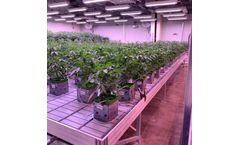Crop Cycle Articles & Analysis
28 articles found
Kamala Farms is a leading name in hydroponic farming in India, and faced its own set of challenges in scaling operations and managing its network of client’s farms. By adopting KhetiBuddy’s farm management solution, Kamala Farms transformed its business process and consulting practices, optimizing its processes and driving significant improvements. Kamala Farms initially struggled ...
One exemplary case of digital transformation is Shree Agro Group’s adoption of KhetiBuddy’s Farmer Engagement and Management Solution. This initiative not only propelled their sales but also strengthened their relationships with farmers and dealers, setting a new benchmark in agricultural ...
Plant growth regulators are widely used in agriculture and horticulture to obtain specific advantages, such as decreasing susceptibility to biotic and abiotic stresses, improving morphological structure, increasing crop yield, and modifying plant constituent. Applications Plant hormones are a class of plant metabolites, playing an unparalleled role in the agricultural field as ...
Indexes plant health status throughout the crop cycle. Predicts best fertilizing windows and computing the most cost-efficient amount of inputs based on crop status, input costs, predictive yields and crop value. ...
ByAGRIVI
Ethics Infinity Pvt. Ltd. (EIPL) supplier of Turnkey solution for the High-tech Greenhouse Projects & Services to the Farmer and Commercial grower. EIPL has expertise, ability and all needed knowledge for establishing greenhouses not only in Gujarat, but allover in India & Sub continent. Our expertise can design and install all kinds of agricultural protective cultivation projects ...
Stepping forward with technological advancements Agriculture is one of the oldest industries known to man, and many traditional methods and commercial farming practices are still unrivalled. However, technological advancements are continuing at a rapid pace, and rather than shun these, commercial farmers can utilise them to improve their operations. Technology will probably never completely ...
Crop steering - an introduction. Crop steering is a fairly new term that’s increased in popularity recently, but some growers have been using crop steering techniques for many years. The phrase crop steering is most often used by cannabis growers in relation to commercial cultivation of medicinal cannabis plants, but is applicable to commercial cultivators across the board. After all, ...
How do you achieve the highest yields with your lighting system? As we know, increasing light intensity up to a certain species-specific point, results in a corresponding increase in yield. And when light levels are not optimized for production, or the type of crop you are growing, you are going to have slower flowering, poor root development and plant structure, as well as reduced yields. There ...
However, drones are not only useful after planting; they can also help create valuable deliverables like variable-rate prescriptions, making them instrumental throughout the entire crop cycle. Before you can get into which type of soil collection process you want to implement, you first need to determine where you’re going to collect your samples. ...
ByGrowers
Whether you’re a grower wanting to extend your season in the hoop house or greenhouse, an urban rooftop farm, or a small indoor start-up—horticultural lighting gives you the flexibility and assurance that you will be growing the highest quality products year-round. With demand for local grown produce increasing, it’s not surprising to see many small growers expand into ...
Lighting for commercial hemp production – 5 tips on how to light your hemp crop for maximum yields, quality and potency. We know that light is essential for plant growth, and for a plant such as hemp, which is adapted to high light levels, and where yields and quality are heavily influenced by light intensity – having supplemental or a high-quality sole source ...
Ornamentals have specific lighting requirements needed to grow high quality and consistent crops. Since many bedding plant varieties are started in winter, lighting becomes important for managing early growth stages and to ensure products are in a condition ready to be shipped to customers. Cut flowers and flowering potted plants require supplemental lighting in low light times ...
There is less water loss because evapotranspiration, row spacing, and crop cycle lengths are less. Possibilities to use drip irrigation and collect and recycle unused water are some other advantages. ...
Irrigation is essential to increase food production. However, competing needs and increasing drought makes water for irrigation scarce. Therefore, new methods and strategies are continuously being tested by scientists to improve food production, accompanied by better water use efficiency. This article will examine how modern field tools are helping in this venture. Irrigation Methods According ...
It involves leaving the previous year's crop residue (such as corn stalks) on the ground when planting the next crop, with little or no mechanical tillage. ...
Having the ideal strength and balance of nutrients at all stages of the crop cycle will help to ensure the best product performance in terms of marketable yield, flavour, texture and shelf-life. ...
Explain that in layman’s terms and what that means for someone who wants to optimally irrigate their crops. David: A crop doesn’t use the same amount of water every day of its life cycle. ...
ByGroGuru
For the past two years, Arable has had the opportunity to spend a considerable amount of time learning from Frank Muller, his son Colin, and the other irrigation specialists on their staff about how to design and implement a specialized irrigation strategy that could shape the way crops are grown and watered. From February through August each year, we have the privilege of ...
ByArable
As this vast amount of data grows, so does the industry’s ability to fine-tune all aspects of the crop and distribution cycle. This not only helps ensure that demands are met but also quickly pinpoints areas of safety concern — whether they be possible contamination by salmonella or the need to quarantine specific harvests that may have been ...
Environmentally sustainable, these coir products are renewable and can be re-used for several crop cycles, depending on your needs and preferences. Environmentally sustainable, coir products does not alter the physical make-up of the environment. ...
















